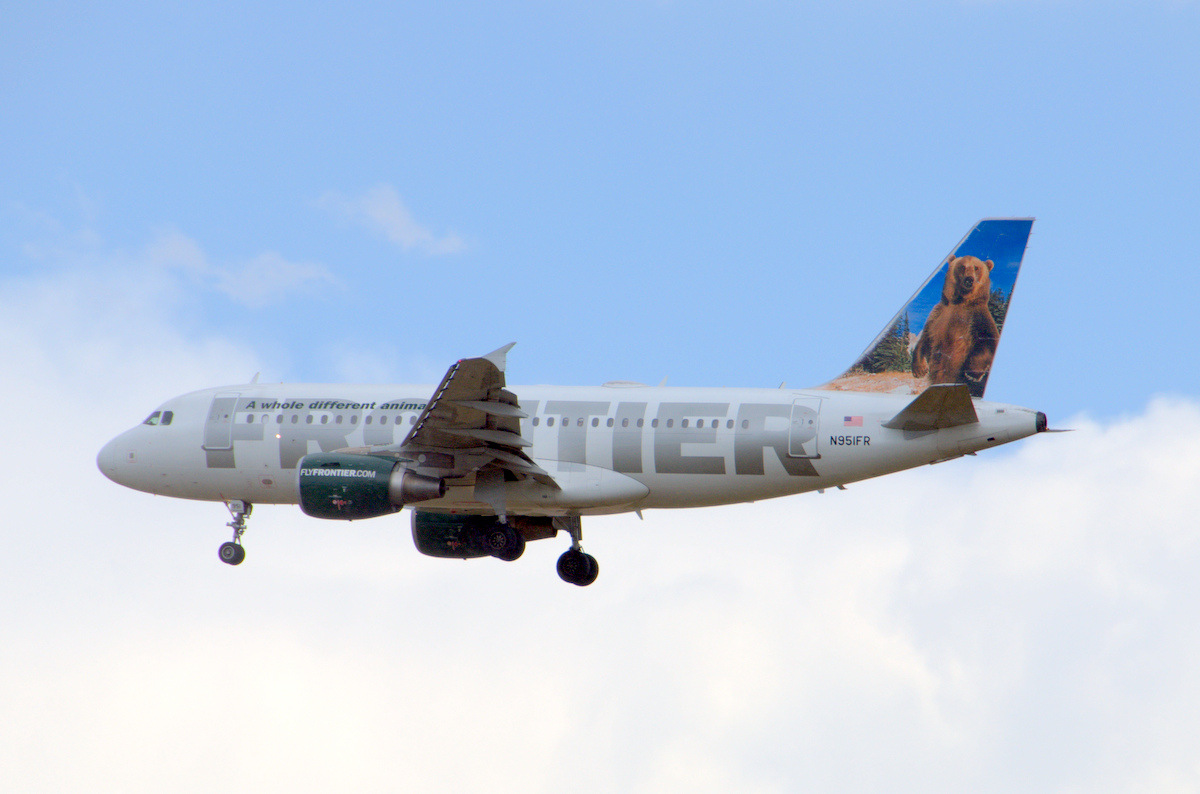
Benny the Bear, an Airbus A319 on approach for Denver International – Photo: JL Johnson | AirlineReporter
It has been a while since we here at AirlineReporter reviewed a mainline Frontier flight, four years to the month, in fact. Since then, Frontier has been freed from Indianapolis-based Republic and has made serious changes to its business model. Denver’s hometown airline and longtime low-cost carrier spent most of 2014 transforming itself into an ultra-low-cost carrier (ULCC). This change was prescribed by the company’s new owners – Indigo Partners. Indigo co-founder William Franke has some experience with ULCCs; in fact he has successfully invested in a number of them, most notably Wall Street’s favorite: Spirit.
I have long wanted to experience Frontier, but the timing and opportunity never worked out. That is until they published a $76 round-trip from Kansas City to Denver. While I wouldn’t necessarily consider myself a “fan” of the ULCC market, domestically they tend to be more interesting than say, the legacies. While I gravitate more to LCCs (like Southwest, Virgin, or JetBlue) it’s fun to check out their ULCC brethren. LCC and ULCC airlines like to suggest that their competitive prices create demand and with a crazy sub $100 fare, I suddenly found a two-day hole right in the middle of my work week.
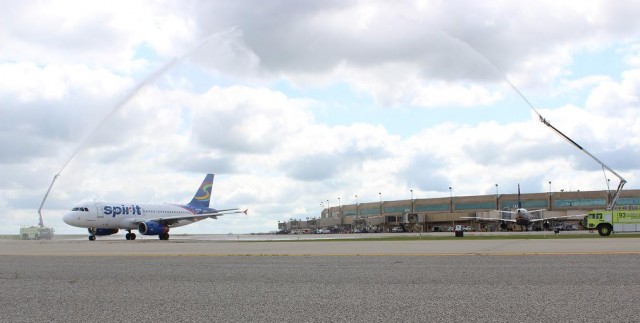
Spirit’s first flight out of Kansas City receives a dual water cannon salute – Photo: Aaron Wright, KC Aviation Dept.
It’s true, people vehemently despise Spirit Airlines. Just the mention of the company elicits emotion-filled horror stories. Indeed they have a solid 1 out of 5 star rating on TripAdvisor, and they are frequently found at, or near, the top of various “worst airline” rankings. In direct contrast to these ratings and frequent “I’ll never fly Spirit again” claims, the airline continues to grow and increase market share. This begs the question – is the experience really THAT bad? Or, is there something else at play here?
BONUS: The Five Stages of Flying an Ultra Low Cost Carrier (Epic Comic Style)
In their own defense, Spirit argues that the mass dissatisfaction with them is in large part due to consumers not understanding their progressive, totally unbundled Ultra Low Cost Carrier (ULCC) business model. That assertion seems to hold water. The vast majority of complaints I hear and see are indeed related to “unexpected fees” and being “nickel and dimed” to death. As the well-known cliche goes: “The first step to recovery is admitting you have a problem.” Thankfully, Spirit recognizes there is a problem. To that end they recently hired Barkley, a KC-based marketing firm to assist with better educating consumers and promoting what they refer to as a “bare fare.”

“Bare Fare” crop circle spotted in a soy field just north of the KC airport – Photo: Victor Lazo
A few months ago, Kansas City International airport announced that ours would be a new market served by Spirit. Shortly after an unexplained crop circle appeared prompting a lot of curiosity. It turned out the image seen above is the logo for Spirit’s Bare Fare.
I was excited to finally have the opportunity to give them a shot, contrary to the advice of everyone who I’d informed of my intentions. I booked a seat on the first flight out, and this is my honest, unbiased review…

My travel map for the USA… Could I tick an extra state off that list? – Image: TravBuddy.com
Each year I set some travel goals for myself; that way throughout all the craziness that may happen during the year, I have a guideline of the things I want to see or do. OshKosh was on my list, as well as my trip home to Australia back in April. I was able to complete those and needed some additional challenges.
I realized fairly late in the year, after returning from New Zealand, that I had left a goal off my list. Being new to living in the USA, I want to see more of this country that I now call home. I had set a goal to add at least one more state to my list of those visited (I was sitting at 42 and I decided that I wanted to make it to at least 43 by the new year).
My colleagues at Airline Reporter found out about this and thought they would have a bit of fun with it. I could check off a state, but I had to do it for less than $100 and make a whole weekend out of it. I accepted the challenge.
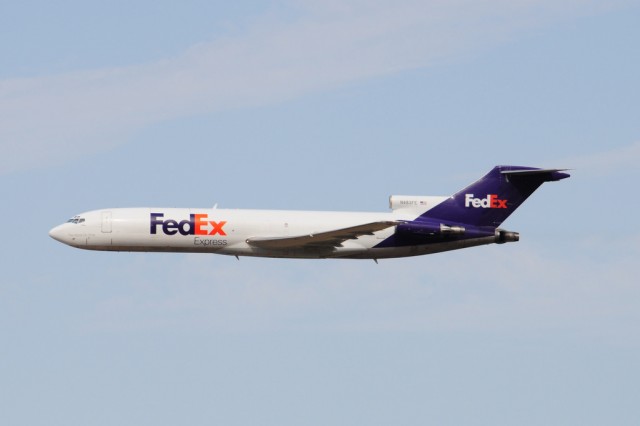
FedEx Boeing 727, named Colin, arrives to Kansas City. Image by JL Johnson.
A blog reader and aviation fan, JL Johnson (@user47), was recently able to witness the last flight and donation of a FedEx Boeing 727. He agreed to share his story and photos with the blog. Here is his story in his own words:
I suspect it’s no news to readers of
AirlineReporter.com, but we aviation enthusiasts are a unique group of folks. Of all the peer-groups I belong to, aviation geeks, that is, avgeeks, are the most loyal, diverse, and enthusiastic I have encountered. One thing I’ve noticed about avgeeks is they always want to deepen their bonds and connections to the industry. Whether it’s catching the newest livery while plane spotting and sharing it on social media, hopping on an inaugural flight, or social networking our ways into typically non-public areas with great aerodome views, we’re always curious. And, with this, I’ve noticed a trend.
It seems the vast majority of folks are focused on what’s new: New planes, new routes, new airlines, etc. And while this is great, it seems I’m more interested in what’s old. Maybe it’s my obsession with history, but I want to be a part of, or at least witness history. Recently, I got that opportunity.
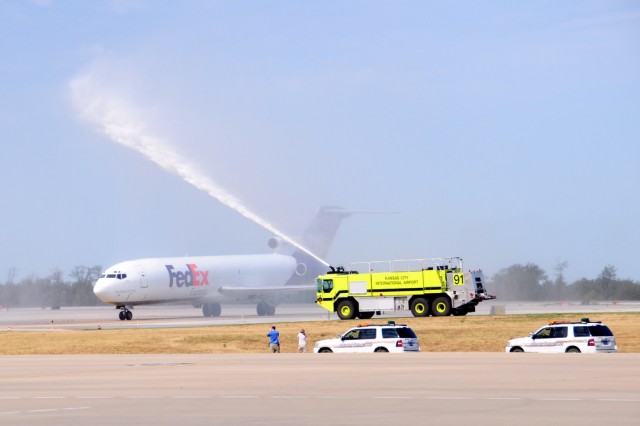
A proper airport welcome at KCI. Image by JL Johnson.
On Wednesday, August 1st at 10:14 AM CDT, a 34-year old Boeing 727 with registry N483FE touched down on Kansas City International Airport’s (KCI) runway 19R marking the end of its life with 34,671 flight hours.
The plane, named Colin, after the child of a FedEx courier, was originally delivered to Braniff Airways in 1978 as a passenger liner. In May of 1990 FedEx Express took ownership of the plane and oversaw its passenger to freighter (P2F) conversion. Shortly after, it entered the FedEx Express fleet where it served alongside dozens of other 727s for 22 years.
While the termination of FedEx Express flight 9044 from Memphis, TN marked the end of the sky for a plane, it highlights a quickening retirement plan for this and other tri-jets in fleets across the world. With higher maintenance costs for older planes and drastically more fuel-efficient alternatives on the market, planes like Colin have quickly fallen out of favor.
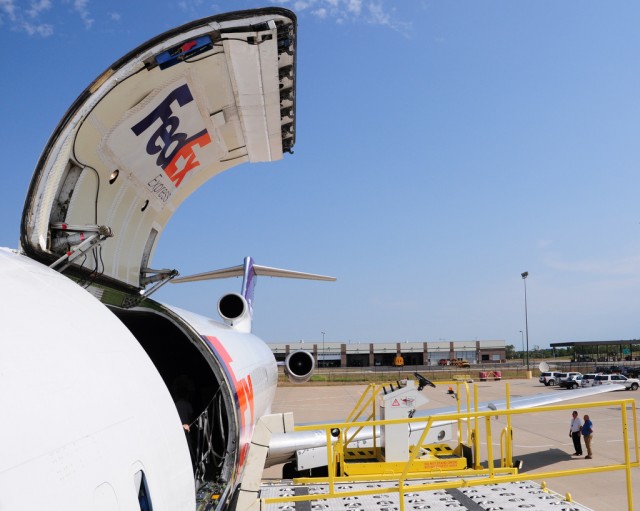
Those Boeing 727s that were converted to freighters increased their lifespan, but for Colin, he is about to start a new chapter. Image by JL Johnson.
So, what’s one of the world’s largest airlines to do with all of these old fuel inefficient planes? According to David Sutton, managing director of Aircraft Acquisition and Sales for FedEx, the solution was simple: Donate the planes to the communities they serve to support educational endeavors.
In 1995 FedEx Express launched their aircraft donation program with the donation of a plane to the FAA who at the time was interested in studying the effects of corrosion and fatigue on aging aircraft. Since then FedEx has donated over 50 airplanes to charities, museums, and airports.
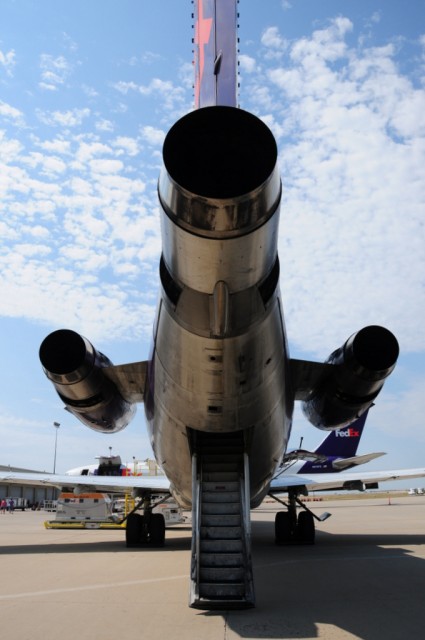
You are not a true avgeek if you don’t love a tri-holer. Image by JL Johnson.
Kansas City Aviation Director Mark VanLoh gladly accepted FedEx’s donation which the airport intends to use for emergency response training. Mr. VanLoh shared with the audience that with this plane, the airport and its crucial emergency responders will no longer be reliant on the generosity of its constituent airlines to loan their planes for training exercises.
In the coming days Colin will be relocated to the southeast side of the airport near an on-site overhaul base where it will lose its engines. While two of the engines will in some fashion make their way back into service, via parts or spares, one will be preserved and donated to the National Airline History Museum where patrons can visit and learn about the low-bypass jet engines that helped usher in the modern era of aviation.
37 PHOTOS FROM THE FEDEX EVENT
About the author: I’m a Kansas City, Missouri based Senior Business analyst with a ridiculous obsession for all things aviation. As an avid plane spotter, I can often be found on or near airport property with a telephoto lens. Let’s get social! I’m on twitter and most other social media as @user47 and occasionally blog over at http://jlsblog.com







